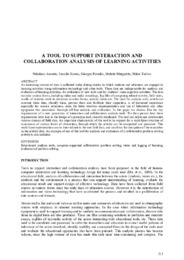| dc.contributor.author | Avouris, Nikolaos | en |
| dc.contributor.author | Komis, Vassilis | en |
| dc.contributor.author | Fiotakis, Giorgos | en |
| dc.contributor.author | Margaritis, Meletis | en |
| dc.contributor.author | Tselios, Nikos | en |
| dc.coverage.spatial | CY - Λευκωσία | en |
| dc.creator | Avouris, Nikolaos | en |
| dc.creator | Komis, Vassilis | en |
| dc.creator | Fiotakis, Giorgos | en |
| dc.creator | Margaritis, Meletis | en |
| dc.creator | Tselios, Nikos | en |
| dc.date.accessioned | 2016-02-16T06:27:00Z | |
| dc.date.available | 2016-02-16T06:27:00Z | |
| dc.date.issued | 2003 | |
| dc.identifier.uri | http://hdl.handle.net/10797/14680 | en |
| dc.description | Περιέχει το πλήρες κείμενο | el |
| dc.description.abstract | An increasing amount of data is collected today during studies in which students and educators are engaged in learning activities using information technology and other tools. These data are indispensable for analysis and
evaluation of learning activities, for evaluation of new tools and for students’ meta-cognitive activities. The data can take various forms, including video and audio recordings, log files of computing-related activity, field notes,
results of students work in electronic or other forms, activity sheets etc. The need for analysis tools, which can annotate these data, classify them, process them and facilitate their inspection, is of increased importance
especially for science education, since the latter involves experimentation and use of laboratory and other equipment that necessitate thorough off-line analysis and evaluation. In this paper we discuss first the key
requirements of a new generation of interaction and collaboration analysis tools. We then present how these requirements have lead to the design of a prototype tool, recently developed. This tool can relate and synchronize
various streams of field data. An important characteristic of the tool is its support for a multi-layer structure of annotations of various levels of abstraction, through which the activity can be interpreted and presented. This
multi-layer representation can be inter-related to the raw field data, and can drive the navigation of the researcher in the activity data. An example of use of this tool for analysis and evaluation of a collaborative problem solving
activity is also included. | en |
| dc.language.iso | eng | en |
| dc.publisher | Department of Educational Sciences, University of Cyprus | en |
| dc.relation.ispartof | Information and communication technology | en |
| dc.rights | info:eu-repo/semantics/openAccess | en |
| dc.rights | Open Access | en |
| dc.source | CBLIS Conference Proceedings 2003 Volume I: New Technologies and their applications in education | en |
| dc.title | A tool to support interaction and collaboration analysis of learning activities | en |
| dc.type | info:eu-repo/semantics/conferenceObject | en |
| dc.subject.uncontrolledterm | Behavioural analysis tools | en |
| dc.subject.uncontrolledterm | Computer-supported collaborative problem solving | en |
| dc.subject.uncontrolledterm | Video and logging of learning | en |
| dc.subject.uncontrolledterm | Evaluation of problem solving | en |
| dc.contributor.conferenceorganizer | Learning in Physics Group, University of Cyprus | en |
| dc.contributor.coordinator | Constantinou, Constantinos P. | en |
